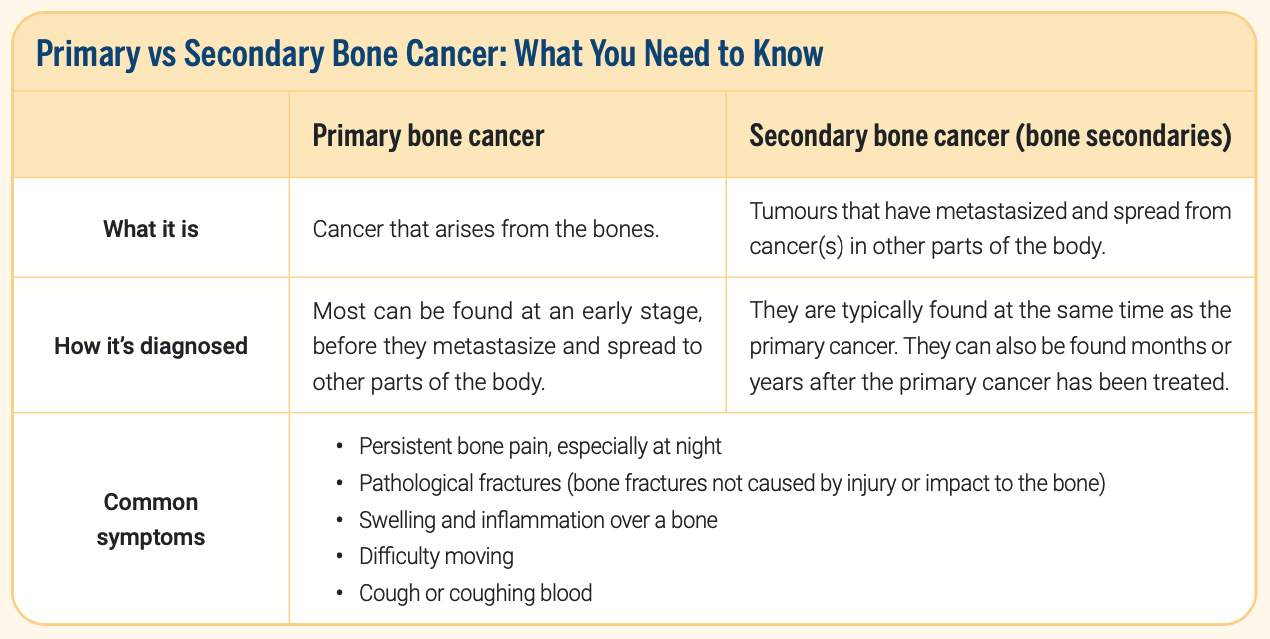News & Articles

Understanding Primary & Secondary Bone Cancer

Bone cancers form some of the most common cancers in children and young adult Singaporeans aged 0–29 years1. But what are they, and how are they managed? Dr Richard Quek, Senior Consultant, Medical Oncology explains.
What are bone cancers?
Bone cancers develop when cells within the bone grow and multiply uncontrollably to form a mass of abnormal tissue called a tumour. They can be classified as primary or secondary bone cancers based on their tumour of origin.
Primary bone cancers are cancers that arise from the bone. They are quite rare, accounting for only a small percentage of new cancers diagnosed across the world.
Common subtypes include osteosarcoma, chondrosarcoma, Ewing sarcoma and giant cell tumour of bone. Each of these subtypes have unique characteristics, including distinct age of presentation, rate of disease progression, molecular basis of the cancer, and treatment strategies, outcomes and response.
Secondary bone cancers, also called bone secondaries, occur when malignant cells from a primary cancer in other parts of the body—such as the lung, breast or colon—spread to the bone. These are generally advanced stage cancers as they have metastasized and spread.

Who is at risk?
Currently, there are no clearly defined risk factors for the development of bone cancers.
Bone cancers may affect individuals of different ages. Children, adolescents and young adults in particular are disproportionately affected by common subtypes of bone cancers such as osteosarcoma and Ewing sarcoma. Chondrosarcoma, meanwhile, tends to affect older adults.
It is relatively uncommon for individuals to inherit genetic mutations that predisposes them to developing bone cancers. However, there are some rare, hereditable genetic disorders such as Li Fraumeni Syndrome that can increase the risk of bone cancers for individuals with these disorders.
Treating bone cancers
Treatment for bone cancers depends on the tumour of origin.
Bone secondaries, for example, are treated based on the treatment principles of the primary cancer, which is in turn determined by the type and extent of the primary cancer. For instance, breast cancer patients with cancer that has metastasized and spread to the bone would have a very different treatment plan from lung cancer patients with bone secondaries, as the primary cancers and its subtypes possess different disease characteristics.
Similarly, treatment for patients with primary bone cancers is based on tumour histology. For example, radiation therapy is not given in the treatment of osteosarcoma as the disease is typically radioresistant. Meanwhile, chemotherapy plays a key role in the treatment of Ewing sarcoma as the disease is highly chemosensitive. In the case of chondrosarcoma, a disease that is resistant to chemotherapy and radiation therapy, surgery is the mainstay of treatment.
Besides the individual nature of the disease, treatment is also personalised and tailored to each patient based on the patient’s general health, treatment outcomes, and treatment response.
Hope for patients with bone cancers
Fortunately for many patients, primary bone cancers are highly treatable. In fact, many patients can be cured if the cancers are detected early. The cure rate for patients with localised osteosarcoma is approximately 70% when treated with chemotherapy and surgery. Meanwhile, the cure rate for patients with localised Ewing sarcoma is about 75%. Even with advanced stage 4 disease, a quarter of Ewing’s sarcoma patients who undergo treatment remain alive with good long term disease control.
Like many other cancers, early detection is key. While there is currently no recommended screening programmes for bone cancers, most bone cancers can be detected at an early stage. If you encounter symptoms of bone cancers such as persistent bone pain, unexplained fractures or notice changes in your body, see your doctor.
1Source: Singapore Cancer Registry Annual Report, 2019
| POSTED IN | Cancer Treatments |
| TAGS | metastatic cancer, primary bone cancer, stage 4 cancer, tumours |
| READ MORE ABOUT | Sarcoma |
| PUBLISHED | 01 September 2022 |
